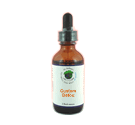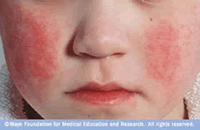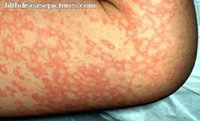|
|
Parvovirus B19
The B19 virus, generally referred to as parvovirus B19 or sometimes erythrovirus B19, causes a childhood rash called fifth disease or erythema infectiosum, which is commonly called "slapped cheek syndrome". You can see why by the photo. The virus is primarily spread by infected respiratory droplets, but blood-borne transmission has been reported.
Fifth disease or erythema infectiosum is only one of several expressions of Parvovirus B19. Any age may be affected, although it is most common in children aged six to ten years. It is named due to being the fifth pink-red infectious rash to be described by physicians.
Infected patients with normal immune systems are contagious before becoming symptomatic, but usually not after. Once infected, patients usually develop the illness after an incubation period of four to fourteen days. The disease commences with fever and malaise while the virus is most abundant in the bloodstream, and patients are usually no longer infectious once the characteristic rash of this disease has appeared. Teenagers or young adults may develop the so called 'Papular Purpuric Gloves and Socks Syndrome'.
Fifth disease is also known for "lace-like" rashes on the arms, legs, torso, and back. These rashes can last for up to 5 weeks and are worse after sun exposure, exercise, or hot baths.
In adults (and perhaps some children), parvovirus B19 can lead to seronegative arthritis. Women are approximately twice as likely as men to experience arthritis after parvovirus infection. Possibly up to 15% of all new cases of arthritis are due to parvovirus. A history of recent contact with a patient and positive serology generally confirms the diagnosis. This arthritis does not progress to other forms of arthritis. Typically joint symptoms last 1–3 weeks, but in 10-20% of those infected, it may last weeks to months.
Although most patients have an arrest of erythropoiesis (production of red blood cells) during parvovirus infection, it is most dangerous in patients who have sickle cell anemia or hereditary spherocytosis, and are therefore heavily dependent on erythropoeisis due to the reduced lifespan of the red cells. This is termed "aplastic crisis" (also called reticulocytopenia) and is generally treated with a blood transfusion.
|
|
| |
Parvovirus Detox Remedy
Detoxification of all Parvovirus and related species
$14.95
Read/Write Reviews
|
 Add
To Cart Add
To Cart |
 |
 |
Herpes Detox Remedy
Detoxification of all Herpes and related species
$14.95
|
 Add
To Cart Add
To Cart |
 |
 |
Influenza Detox Remedy
Detoxification of all Influenza and related species
$14.95
|
 Add
To Cart Add
To Cart |
 |
 |
Mumps Detox Remedy
Detoxification of all Mumps and related species
$14.95
|
 Add
To Cart Add
To Cart |
 |
 |
|
|
 Arthropod/Vector
Bacteria
Chemicals
Fungus /Mold
/ Yeast Metals Parasites Virus Other
Arthropod/Vector
Bacteria
Chemicals
Fungus /Mold
/ Yeast Metals Parasites Virus Other



